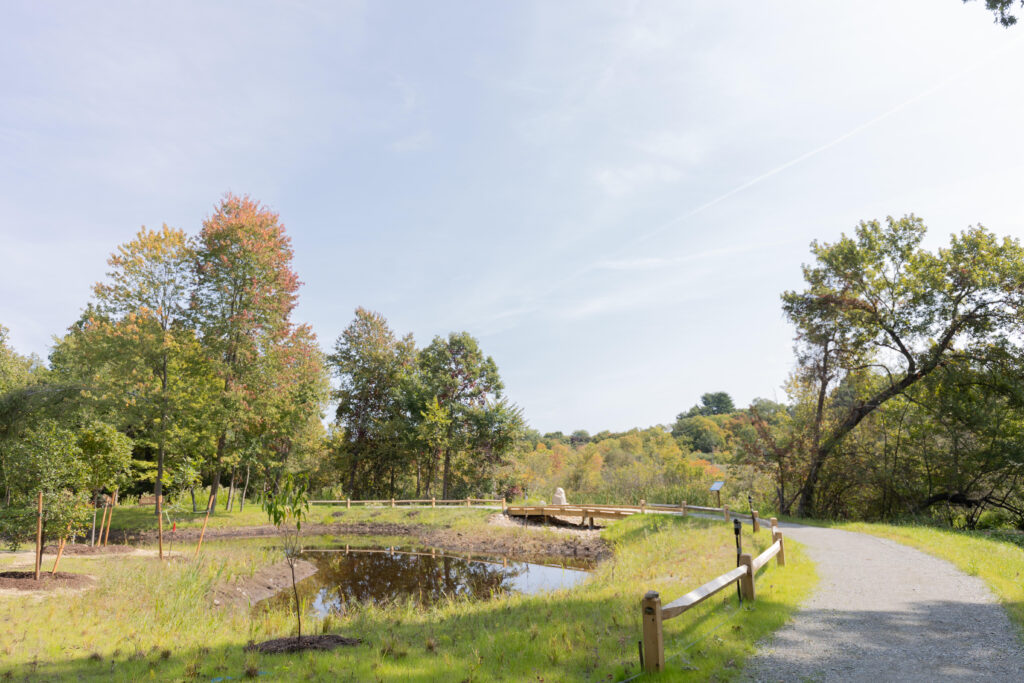Climate Resiliency Project Ribbon Cutting to occur Tuesday, October 1 at 3:45pm.
Congressman Moulton and State Delegation to attend

Reading, MA — The Town of Reading today announces that it will host a brief press conference and ribbon cutting ceremony at the Maillet, Sommes & Morgan Conservation Land (62 Willow Street) on Tuesday, October 1 at 3:45pm. The event will showcase this special stormwater and conservation project that is now complete. The State Delegation of Senator Jason Lewis, and Representatives Bradley Jones and Rich Haggerty, as well as Congressman Seth Moulton and EEOA Undersecretary Katherine Antos will be in attendance. The public is encouraged to attend. Parking is available at Austin Preparatory School at 101 Willow Street in Reading beginning at 3:30pm, with the press conference at 3:45PM followed by opportunities for trail exploration and discussion with project staff.
“Seeing this project develop over the past several years has been truly inspiring,” said Reading Town Manager Matt Kraunelis. “By creating this transformative space, we’ve paired an innovative solution to a pervasive problem in the flooding of the Aberjona River with a beautiful natural area for the residents of Reading to enjoy. I want to extend my deepest thanks to the delegation for their support in securing these funds, Town staff, especially our Planning, Conservation, DPW, and Engineering departments for their work here, our engineering team at Horsley and Witten, and our contractor T. Ford for bringing this vision to life. I’d be remiss not to mention the abutters and other residents; thank you for your patience during this construction!”
This improved conservation area, which has been several years in the making, is fully complete: it now boasts a fully accessible walking trail system from entrances on Willow Street and Lowell Street with additional access located off Hunt Street. Intertwined amongst the thousands of native plants, shrubs and trees are a series of newly created stormwater ponds, designed to improve the quality of stormwater and its runoff by filtering sediments and pollutants through the treatment train and series of wetlands and marshes now present in the area.
Educational signage and information on native trees, plants and wetland systems throughout the area detail the experience and importance of the project.
Funded by a multi-year Municipal Vulnerability Preparedness (MVP) Action Grant, as well as a Congressional Earmark, and local funding, the site reopens after a year of construction and many years in planning. In addition to the improvements to stormwater, the constructed wetlands reduce flooding, enhance open space, expand the existing path and trail system, and improve wildlife habitat.
“Stormwater storage and flood mitigation are issues facing many areas of the Commonwealth, and creatively engineered solutions like this one are the way of the future,” remarked Congressman Seth Moulton (D-MA 6 th District). “I was proud to secure $2 million in federal funding to support this new stormwater system.
Making this project a reality is a true collaboration between federal and state government, and I’m grateful for the efforts of all involved for bringing such an important environmental and recreational area to Reading.”
“The Healey-Driscoll Administration is thrilled to support this project through the Municipal Vulnerability
Preparedness grant program,” said Katherine Antos, Undersecretary of Decarbonization & Resilience,
Massachusetts Executive Office of Energy and Environmental Affairs. “From conception to construction, the Maillet, Sommes, & Morgan Conservation Area in Reading is an innovative regional example of how to manage stormwater in a smart, sustainable manner that protects residents in the Mystic River watershed.”
